Karabina GD Bakalova (Bulgaria)
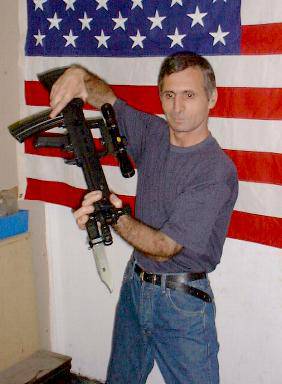 The Bulgarian defense industry cannot boast with a large number of own developments in the field of small arms weapons. Before the collapse of the Warsaw Treaty Organization (ATS), this country produced only copies of Soviet-made small arms and almost did not deal with its own projects of such systems. The situation changed dramatically in the early nineties. Several designers took up the design of new pistols, machine guns and other weapons. One of such pioneers was designer Georgi Delchev Bakalov (not to be confused with Soviet / Russian gunsmith Vasily Ivanovich Bakalov, who worked at TsKB-14, TsKIB SOO and KBP). In the mid-nineties, he presented immediately two projects of small arms for various purposes. His designs were proposed for use in law enforcement and the armed forces.
The Bulgarian defense industry cannot boast with a large number of own developments in the field of small arms weapons. Before the collapse of the Warsaw Treaty Organization (ATS), this country produced only copies of Soviet-made small arms and almost did not deal with its own projects of such systems. The situation changed dramatically in the early nineties. Several designers took up the design of new pistols, machine guns and other weapons. One of such pioneers was designer Georgi Delchev Bakalov (not to be confused with Soviet / Russian gunsmith Vasily Ivanovich Bakalov, who worked at TsKB-14, TsKIB SOO and KBP). In the mid-nineties, he presented immediately two projects of small arms for various purposes. His designs were proposed for use in law enforcement and the armed forces.Carabiner for police
In 1995, GD Bakalov received a patent for a new carbine of his own design. This weapon was intended for the police, namely for units involved in special operations and therefore in need of powerful weapons. In the design of his carbine, Bakalov used several ideas and solutions that were widely spread, but the overall look of the weapon was to some extent original and unusual.
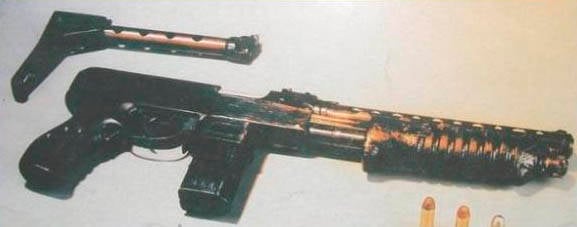
Outwardly, the "police" carbine Bakalova resembled a machine gun or a submachine gun. The weapon had an elongated receiver, a pistol grip and a box magazine installed in front of the trigger guard. The barrel was covered with a cylindrical casing with perforations, starting from the receiver and continuing to the muzzle. However, despite the characteristic appearance, the carbine had nothing to do with automatic weapons. For some reason, the author of the project decided to build weapons based on the so-called. pompovoy scheme. The forend was made movable and rigidly connected to the bolt carrier.
Of great interest was the choice of ammunition. According to reports, the Bakalova carbine had to be equipped with barrels of different caliber, which allowed the use of .45 and .50 revolver cartridges. Probably, this choice of cartridges was due to the peculiarities of the mechanisms of the weapon and the characteristics of the cartridges. For example, the .45 Colt cartridge with a shell-free bullet has a relatively high stopping effect. In addition, when shooting in confined spaces, for example, in premises, a bullet without a shell practically does not give ricochets.
According to some sources, the “police” carbine Bakalova was supposed to be produced in three versions with different trunks: with a rifled barrel of the .45 caliber, with a rifled .50 caliber and with a smooth-bore (unknown caliber). Such a feature of the carbine, apparently, was to provide greater flexibility in its use and thus interest potential customers. As it turned out later, such measures turned out to be useless.
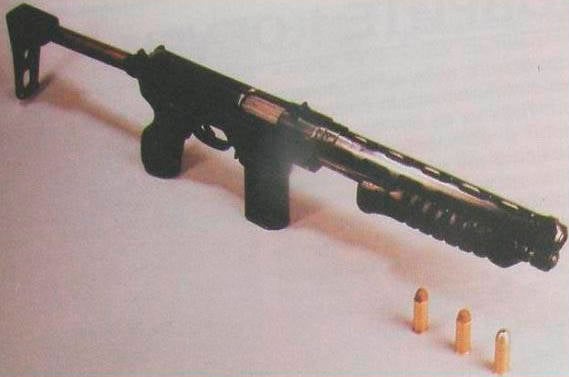
It is possible that the desire to create modifications of weapons for different cartridges and was the reason for the rejection of automation and the use of a pump system. To prepare the weapon for a shot, it was necessary to take the forearm to the rearmost position and return it back to the frontmost position. At the same time, the hard thrusts that bound the bolt group and the fore-end, took the bolt to the rear position, thanks to which he could take a cartridge from the magazine and send it to the chamber. Barrel locking was done by turning the bolt on two lugs. The absence of any automation allowed to simplify the design of the weapon. Karakina Bakalova consisted of only 30 parts.
The carabiner was proposed to be used with detachable box magazines for 10 and 20 cartridges. Stores were to be placed in the receiving window of the receiver and secured with a latch. The design of weapon receiving units resembles to a large extent similar parts of Kalashnikov assault rifles.
For obvious reasons, GD carbine Bakalova could fire only single shots, which, in particular, affected the complexity of the firing mechanism. For the safe handling of weapons in the trigger was included non-automatic fuse. His lever was pulled out in front of the trigger guard.
The carbine sights were simple: he got the usual open sight. The front sight was above the barrel barrel, the sight was on the receiver box, above the breech breech.
The carbine received a metal butt of a characteristic L-shaped form. If necessary, the butt could be removed from its attachment and transported separately from the weapon. This made it possible to reduce the dimensions of the carabiner, as well as to simplify its design due to the absence of any hinges.
The full length of the Bakalov carbine (with the butt) reached 710 mm. No stock - 495 mm. Weapons without ammunition weighed 2,7 kg. According to reports, the sighting distance of the carbine did not exceed 300-400 m. At a distance of 300 m, bullets of several shots "fit" into a rectangle with dimensions 30x40 mm. An important feature of the carbine was the simplicity and low cost of production. According to some information, at the price of one Kalashnikov rifle, the police could buy three Bakalov carbines at once.
In 1995, the designer received a patent for his development, but then, apparently, it did not work. The existence of prototypes of the new carbine is known, but there is no information on the adoption and procurement of weapons. Apparently, the potential customer, represented by the Bulgarian police, was not interested in these weapons and did not purchase them. Reasons for failure are unknown. There is reason to believe that the fate of the “policeman” carbine Bakalov was affected by its specific appearance and the incomprehensible tactical niche.
However, the Bakalova carbine is of some interest. This weapon combines the simplicity of design, low cost of production and the relatively high power of the selected cartridges. The use of weapons could be hampered due to the lack of automation, but the pros and cons of the carbine from the tactical point of view could only be shown by tests and experience of using them in real operations.
Assault carbine
In 1996, Bakalov received another patent. At this time, the subject of the document was a new machine, intended for the armed forces. The weapon received the name ShchKB ("Shchturmova Bakalova carbine" - "Bakalov assault carbine). While developing a new project, the designer tried to create modern small arms for the army, having characteristics at the level of other systems of this class, and also capable of using various ammunition. ShchKB machine gun could use Soviet intermediate cartridges 7,62x39 mm, NATO intermediate 5,56x45 mm and NATO rifle 7,62x51 mm. It should be noted that the SCHKB carbine was the first machine gun developed in Bulgaria.
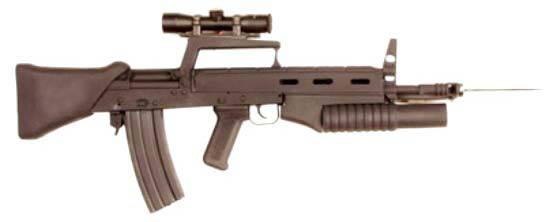
Knowing the state and possibilities of the Bulgarian defense industry, in the new project Bakalov decided to use the components and assemblies already mastered in production. As a basis for the new weapon, AK series machines were chosen, which became a source of borrowed ideas and details. Nevertheless, following the latest trends in the field of small arms, Bakalov decided to build a SCHKB carbine according to the bullpup scheme, which made it possible to reduce its dimensions while maintaining the required characteristics. Despite all the innovations, SCHKB can be considered another deep modification of the Kalashnikov assault rifle, since these types of weapons are unified by 64% (46 borrowed parts from 72).
The new layout made it necessary to seriously modify some units of the basic automata. Thus, the receiver was changed to reflect the different location of the fire control knob and the installation of a new forearm. In the back of the receiver was provided with a plastic shoulder rest characteristic shape, covering the receiver. The receiving window and the magazine latch remained in place, and the pistol grip, trigger and safety bracket were moved to the front of the weapon. The trigger and trigger mechanism were connected with a special thrust.
The trigger mechanism has undergone some changes. The flag of the translator of fire was not provided. To control the mode of shooting was supposed to change the effort on the trigger: with an incomplete pressing, a single shot was made, with a full press - a turn. It is known about the development of USM modification, which allows shooting in bursts with a cut-off of three shots. For the safety of the use of weapons received automatic fuse. To disconnect the fuse, it was necessary to pull the trigger with a certain effort.
Changing the layout of the weapon allowed Bakalov to use the new barrel length 450 mm with a muzzle brake-compensator of the original design. Like the basic Soviet-made automata, the ShchKB had a gas outlet tube with a gas piston above the barrel. The bolt group was borrowed from Kalashnikovs with minimal changes, primarily associated with the use of other cartridges. The overall layout of this unit has remained the same.
A characteristic feature of all weapons, built on the bullpup scheme, is a high line of aiming, due to the layout of the units. Because of this, Bakalov had to equip the carabiner with a relatively high front sight and a carrying handle on the receiver. At the last was an open sight. The aiming line length was 330 mm, the design of the sight with four positions of the rear sight allowed to fire at distances 100-200, 300, 400 and 500 meters.
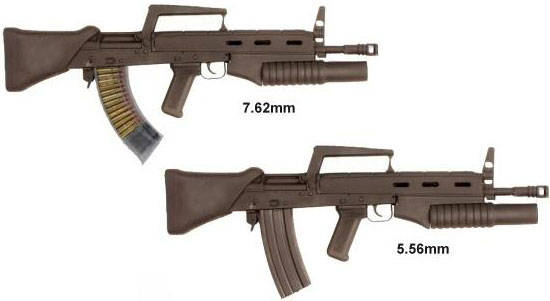
Carabiner SCHKB, depending on the modification, had to use one of three box-shaped detachable magazines with a capacity of 30 cartridges. Each of them was intended to equip cartridges of its type. At the same time, the magazine for 7,62x39 mm cartridges was a modified magazine from AK / AKM machines. Shops for 5,56x45 mm and 7,62x51 mm cartridges were made on the basis of corresponding foreign developments, but they had an upper part compatible with the mechanisms of AK / AKM and SCHKB automata.
The carrying handle provided for mounting for sights of various types. If necessary, the shooter could use not only a standard open sight, but an optical one of the desired type. At the muzzle of the barrel were attachment for a bayonet, borrowed from Soviet weapons.
The bullpup layout was fully justified: with a barrel length of 450 mm, the total length of the carbine was equal to 740 mm. Weapons without ammunition weighed 3,7 kg, with a magazine and 30 cartridges 7,62x39 mm - 4,52 kg. If necessary, the shooter could equip his weapon with a sight of the required type, a bayonet or a rifle grenade launcher.
A barrel longer in comparison with Kalashnikov assault rifles allowed the initial bullet velocity to be brought up to 750 m / s (cartridge 7,62х39 mm). The sighting range was limited to 500 meters. The rate of fire ranged from 600 to 900 shots per minute.
In the second half of the nineties, GD Bakalov was able to agree with the management of the Arsenal plant (Kazanlak) on the production and testing of a new assault carbine. Several ShchB units were manufactured and tested in versions for the use of different cartridges.
Tests were conducted during which the SCHKB carbine was compared with an AK machine gun. The Bulgarian weapon had an advantage in size, initial bullet speed and rate of fire. Effective muzzle brake compensator significantly reduced recoil force. At the same time, the SCHKB yielded to the Soviet competitor in accuracy and accuracy of fire, weight and reliability of work. According to the test results, the automatic rifle AK was rated 0,93, SCHKB carbine - 0,84.
The competition commission decided that the new development of Bakalov does not have significant advantages over existing weapons. In some respects, the SCHC exceeded AK, in others it lost to him. Because of this, in the final part of the test report, it was recommended to continue the development of an assault carbine with the aim of eliminating deficiencies, improving performance and simplifying production. The test completion document was signed in the middle of 2001.
According to reports, in the future Bakalov continued the development of his project and took some measures to improve the performance of the carbine. In addition, he again offered the military this weapon in a modified version. In April 2005, the Bulgarian Ministry of Defense reiterated a document concerning the SCHKb carbine. The military again abandoned their proposed weapons due to insufficient characteristics. The further fate of the project is unknown. Perhaps Bakalov continued to refine the project, but since 2005, there have been no new reports about the SCHKB carbine.
On the materials of the sites:
http://dogswar.ru/
http://tonnel-ufo.ru/
http://orajie.start.bg/
http://raigap.livejournal.com/
Information